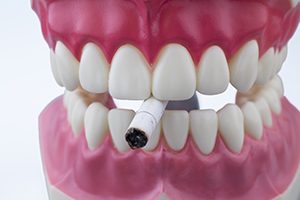What You and Your Mouth Need to Know About Cancer
 Early Detection Remains Key
Early Detection Remains Key
Just as in any good crime show, the sooner the heroes discover the problem and get to work solving it, the better the outcome. Looking inside your mouth provides us a unique opportunity to detect other potential health problems, particularly the signs of oral cancer.
Did you know that you get what amounts to a mini-cancer screening with every routine dental examination? And we continue to evaluate new screening products as they appear on the market.
For most of our patients, the news is always good. Nevertheless, oral cancer is expected to be diagnosed in over 35,000 Americans this year. Survival rates are not improving; only half those patients will still be alive five years from diagnosis.
The reason? It doesn’t get detected in time. So we pay special attention to patients considered more likely to be at risk. This includes:
- those who consume tobacco in any form, or alcohol—and especially both,
- men, who have twice the risk as women,
- adults over age 40, who make up 95 percent of those diagnosed with oral cancer,
- members of ethnic minorities.
This Heads Up Gives You a Leg Up
One reason oral cancer is such a threat is that it can be painless and practically invisible to its victims. Your regular dental examination, therefore, allows us to detect the early signs of disease. You’re in a much better position to combat the problem than those who wait for the appearance of obvious symptoms.
What if I’m Diagnosed…?
Chemotherapy
Even if it’s not oral cancer that’s being treated, it’s important to schedule a thorough oral examination before beginning radiation or chemotherapy. Cancer therapy poses potential problems for your mouth: gums and the inner mouth may become sensitive or develop sores; lips may crack or peel.
Good news! We can deal with these conditions by coordinating with you and your cancer physician before chemotherapy begins! Typically mouth changes are at their worst shortly after receiving chemo and can be expected to heal during the recovery period.
At times during the treatment cycle, a patient may encounter periods of reduced resistance to infection and decreased blood-clotting ability. Oral hygiene becomes more important than ever.
About 80 percent of all chemo patients end up back in the hospital during chemotherapy with high fevers. While the origins of these fevers aren’t clear, they can be caused by infection. Oral infection or periodontal disease are possible sources.
Every patient is different. If remembering to brush and floss can keep you out of that 80 percent, it’s worth a shot, right? We care—that’s why your oncologist and our staff need to communicate.
Radiation
Radiation directed to eliminate cancers in the head and neck area can affect salivary flow, leading to chronic dry mouth and a higher incidence of tooth decay. This is especially serious if you have periodontal disease or teeth that are badly decayed and non-restorable.
The poorer the condition of your teeth and gums, the less resistance they provide against the effects of radiation. If you’re about to undergo head and neck radiation therapy, we strongly recommend that you schedule an appointment two weeks beforehand for:
- a thorough dental exam,
- a thorough tooth cleaning,
- dental impressions for custom fluoride trays,
- hygiene instructions,
- post-radiation therapy dental treatment planning.
Cancer, oral and otherwise, is a serious concern. But in many cases it IS survivable. In our dental office we’re concerned about your teeth AND your overall health. That commitment has helped us save lives in the past…and it will do so in the future!
Symptoms to Watch for
- A lump or mass which can be felt inside the mouth or neck
- Pain or difficulty in swallowing, speaking or chewing
- Any wart-like masses
- Persistent hoarseness
- Any numbness in the oral/facial region
- Persistent ear ache in one ear
- A white or red patch of tissue in the mouth
- A small ulcer resembling a canker sore
Ask your doctor about any sore or discolored area in your mouth which does not heal within 14 days.
![]()
About Yuri Kaneda, DDS
Dr. Yuri Kaneda was born in Japan and immigrated to the US when she was 4 years old with her family. She lived in Ohio, Nebraska, and Illinois before finally settling in the San Diego area. A graduate of Bonita Vista High School, she went on to the University of California Berkeley where she obtained her Bachelors in Microbiology and Immunology. After working for 2 years in growth plate research at University of California San Diego, she went to the University of California San Francisco Dental School for her Doctor of Dental Surgery degree. Upon graduation, she returned to San Diego where she worked as an associate in the practice of Drs. Morimoto and Yaryan, her childhood dentist. She then started her own practice in 1995 and has been at her present location since 1999 which happens to be across the street from her high school!
View all posts by Yuri Kaneda, DDS →
Appointments
To schedule an appointment please email us at [email protected].

